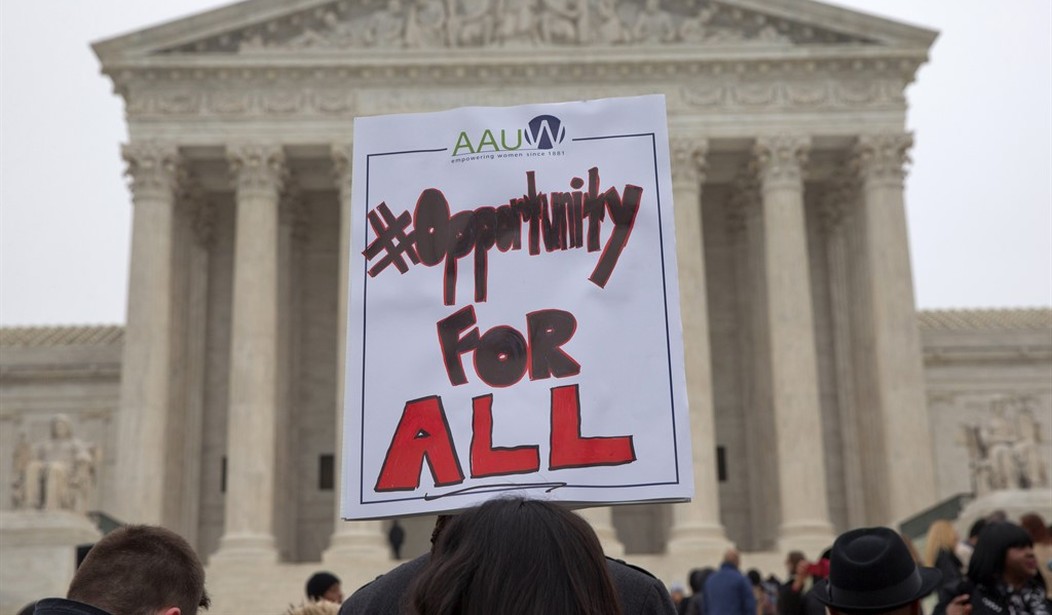The Supreme Court’s ruling on Thursday effectively ends the practice of using race to determine college admissions. Far more than that, it ends the stated goal of most universities to create “diverse” student bodies with little regard for merit or achievement.
Everything from admissions to student financial aid will be impacted by this decision. Beyond college, minority participation in the workforce will also be affected.
“Equality” instead of “equity.” And the left is incensed that schools will be mostly prevented from accepting students based on the color of their skin.
Black, Hispanic, and Native enrollment will drop without consideration of race. On average, these students have lower test scores, lower GPAs, and fewer high-tier extracurricular accomplishments than White or Asian students. The SAT and ACT show the largest score differences among these metrics, particularly at higher percentiles, while GPA and extracurricular resumes have smaller but still significant differences*.* The net result is that for selective schools like Harvard, Amherst, or Northwestern, there are very few Black, Hispanic, or Native students with the kind of academic profile that their institution targets. To achieve diversity on campus, these institutions end up accepting Black and Hispanic students with lower grades and (especially) test scores – if the typical enrolled Asian or White student has an SAT score of 1530 or higher, enrolled Black and Hispanic students will be closer to a 1400 or 1450.
Affirmative action advocates argue that black and Hispanic students need affirmative action because their lower test scores and lower grades are due to cultural differences with whites and Asians — that a racist system is what holds these students back. And also, test scores and high school grades are poor indicators of how well a student will perform at university-level classes. Because of that, why not fill the ranks of incoming students with blacks and Hispanics who are just as likely to perform well as white and Asian students in order to “diversify” the student body where all will benefit?
The issue is not as cut and dried as many on the right make it out to be. Nor should the current hysterical reaction on the left be seen as anything else but political gamesmanship. This is an issue with many complexities that neither side is willing to debate.
Using diversity as an end-all and be-all justification for college admissions is lunacy and patently unfair. But using test scores and grades as the primary criteria for admission to quality schools is also unfair.
Diversity as a goal is commendable. Exposing young people to all races and ethnicities, cultures, and nations is part of a complete education. But how that is achieved is just as important as the goal itself. And the left’s ideas about affirmative action (more accurately, “quotas”) are not the best way to reach that goal.
Affirmative action was a shortcut to diversity. Now colleges and universities are going to have to work a lot harder if they want to achieve their diversity goals. As Vox points out, it’s not an impossible task.
Among the many sobering findings in the California study was a decline in highly qualified Black and Hispanic applicants to the UC system. In other words, the publicity surrounding the ban may have mistakenly convinced some students they shouldn’t bother to apply.
The decision may also prompt more colleges to implement “test-optional” policies of not requiring SAT and ACT scores for admission, a practice that was widely adopted during the pandemic and would likely benefit Black and Hispanic students with lower test scores but strong high school grades.
While the Supreme Court has barred the direct consideration of race, colleges can still legally consider other factors that have the effect of increasing racial and ethnic diversity. Texas, for example, enacted a well-known “Top 10 Percent Plan” in 1997 that guarantees the top 10th of every high school’s graduating class admission to the University of Texas.
After 40 years of using affirmative action to determine college enrollment, schools will have to scramble to create new pathways to academic success for blacks and Hispanics. Studies have shown that in the immediate aftermath of affirmative action bans in nine states, there was a precipitous drop in minority representation at elite schools.
But whose fault is that? The Supreme Court decision didn’t say that the only criteria schools can use for enrollment are grades and test scores. The court just said they can’t use race as a factor. Surely elite academic schools can create better ways to judge the ability of a kid than checking a box next to the student’s race.
